Inca and Colonial Bridges in Cusco – Inca Bridge Machu Picchu, Q’eswachaka | The Inca civilization was mainly accentuated in the Andes of Peru, Bolivia and Ecuador because of the abundance of water and fertile lands for practising agriculture and animal husbandry, and its economy was based on two principles: Reciprocity and Re-distribution.
In order the make the principles happen the Incas people built about 40 thousand kilometres of road that connected the entire territory, from Pasto to Salta, however, the Andean geography is not flat, instead, it is made up of mountains and many rivers, to connect the treks in the rivers, the Inca people built hundreds of suspension bridges made out of straw.
Es importante señalar que el territorio Inca estaba dividido política y geográficamente en cuatro regiones que se llamaban “Suyo”, existían caminos primarios y secundarios, los caminos primarios se conocían como “Qapaq Ñan” y eran las redes viales más grandes y mejor implementadas, que conectaban las cuatro regiones.
It is important to note that the Inca territory was divided politically and geographically into four regions called “Suyo”, there were primary and secondary treks, the primary treks were known as “Qapaq Ñan” and those were the largest and best-implemented trek networks to connect mainly the four regions to Cusco city, the capital.
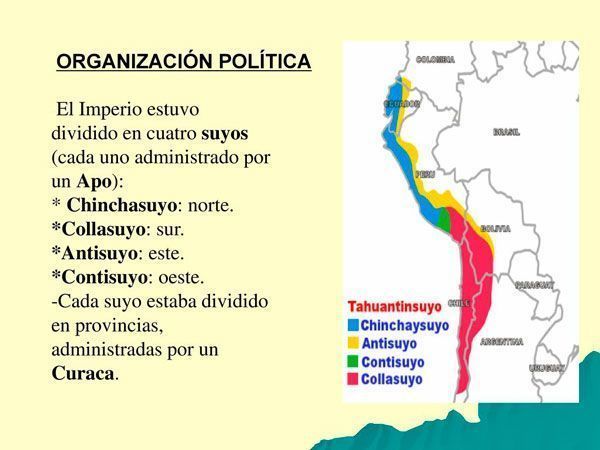
The Spaniards arrive at Peru in 1532 and re-used 100% of the Inca treks, however the Inca bridges are replaced by the Roman Arch shaped bridges.
Today only a few Inca and Colonial bridges remain because they have been destroyed by time and modernity.
Contents
The Last Inca Bridge of Q’eswachaka
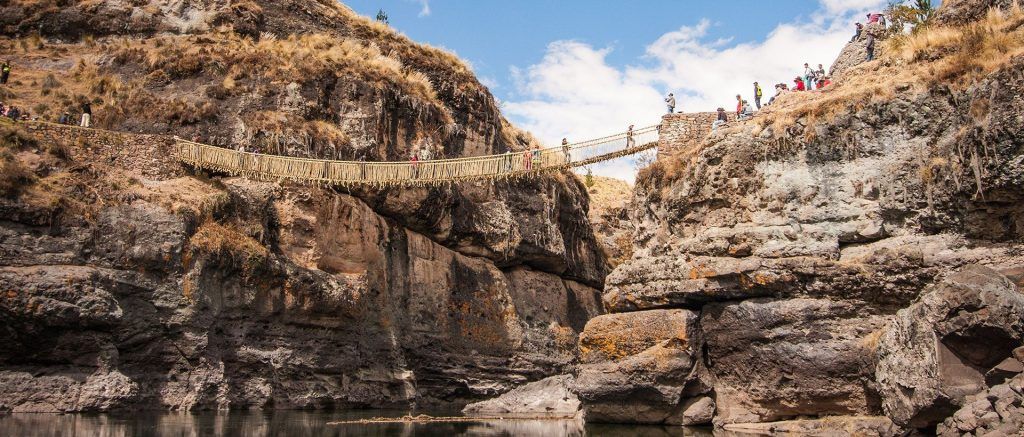
This is the only “living” Inca bridge of the 21st century in use because there were no colonial bridges to replace this beauty of Andean engineering, it is made of vegetable fiber or straw, the Andean people call this vegetable “Ichu” in the Quechua language.
The bridge has a distance of 30 meters and is located in the Huinchiri community (Quehue district, in the south of Cusco) on the Apurímac river.
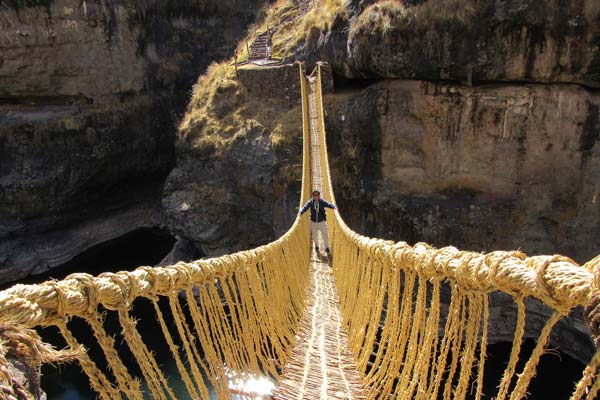
Q’eswachaka is the last Inca bridge actively used by locals, it was also part of the extensive network of roads or Qapac Ñan, recognized as “Cultural Heritage of Humanity” by UNESCO in 2013.
The Restoration of the Q’eswachaka Bridge
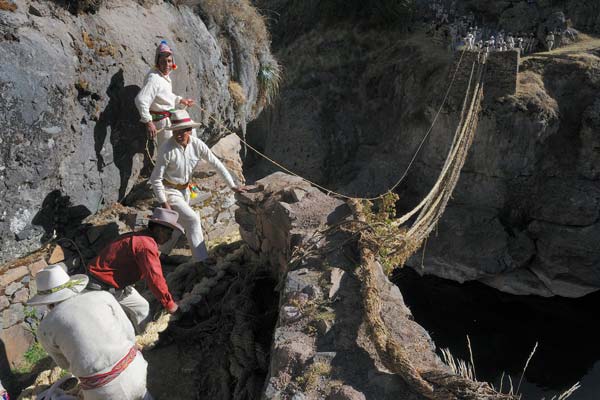
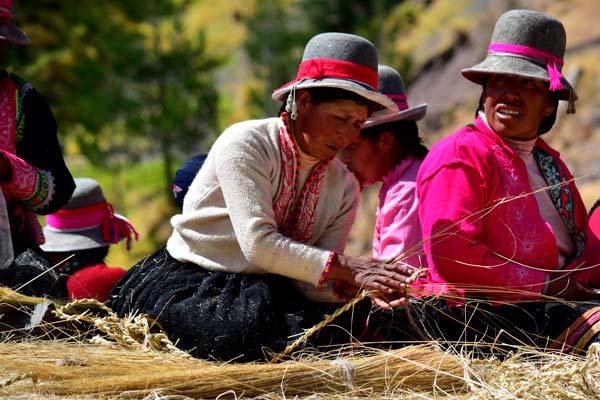
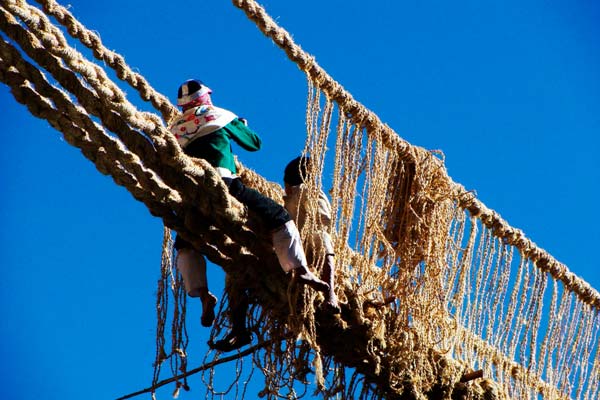
The Indigenous communities of Hunchiri, Chaupibanda, Choccayhua and Ccollana Quehue are in charge of the bridge reconstruction, which takes place in the second week of June of each year, the reconstruction lasts three days and on the fourth day, the bridge is inaugurated with a folkloric and ceremonial festival.
Recommendations to get to the last Inca bridge:
On your own:
- Take the buses that go to Sicuani on Avenida Manco Capac N ° 802, but you have to get off in COMBAPATA city (way before arriving at Sicuani city), the buses normally leave every 1 hour. Please confirm the Bus terminal location to Sicuani with IPERU, you don’t have to go to their office that is in the Plaza de Armas of Cusco next to the church of La Compañía de Jesús, you can just call them, dial +51 84 237364 , they speak Spanish and English.
- Then follow the following route:
- Cusco – Combapata – Yanaoca – Quehue – Qeswachaka Bridge, you will have to take several colectivo buses.
- We recommend you doing this day trip on Sundays, because there is a festival in Combapata (The indigenous people bring cows, horses, llamas, guinea pigs, sheeps, crops, textiles, etc to sell).
- Time and Cost:
- Cusco to Combapata: 2 hours – 7 Soles
- Combata to Yanaoca: 35 minutes – 5 Soles
- Yanaoca to Qehue: 35 minutes – 6 Soles
- Qehue to Qeswachaca: It is recommended to go on foot, it lasts 1 hour maximum, one way. If you don’t want to walk, there are also taxis in Quehue, they charge 30 Soles, one way – If you want a round trip taxi, it costs 50 Soles, it includes 1-hour waiting at the attraction by your driver.
- The entrance to this bridge is Free!
- Important! If it got late and you can return to Cusco on the same day, don’t worry, in Quehue, Yanaoca or Combapata, there are several basic accommodations.
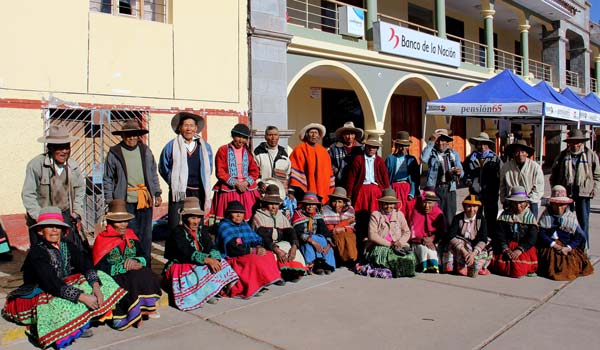
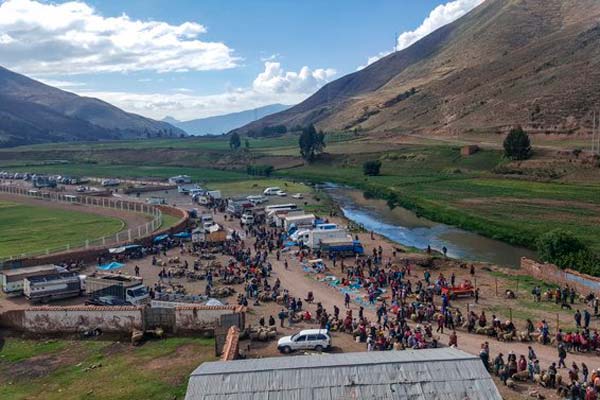
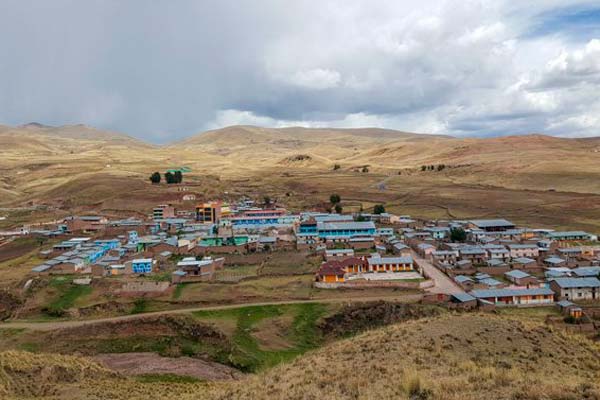
Through a travel agency:
You can go to the main square of Cusco and get a quote, we always recommend hiring an agency with authorization and good comments on TripAdvisor or Facebook, you can also see our one-day Queswachaka Tour.
The Three Bridges of the city of Checacupe
In the southern part of Cusco there is a district called Checacupe where you can see three bridges over the Pitumarca river, each bridge represents a clear stage in our Peruvian history: Inca, Colonial and Republican.
Inca bridge of Checacupe
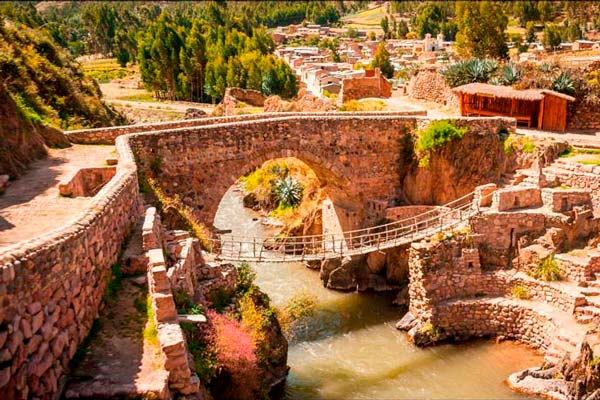
It is estimated that the Inca Bridge was built in the early fifteenth century, during the reign of the 8th emperor called Wiraqocha, it is made of straw and was part of the Qapaq Ñan that connected the Qollasuyo. Keep in mind that in the Andes there was a lack of wood (the Eucalyptus and the Pine trees did not exist in the Inca period), in addition to this the Andean man had no knowledge about the Roman Arch, that is why the Straw (natural fiber) was used.
Colonial bridge of Checacupe
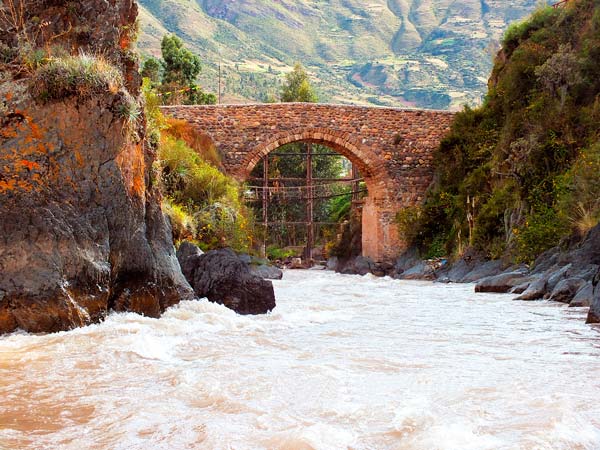
The colonial bridge was built in the 17th century by order of King Carlos III of Spain between 1759 and 1788. It is made of ashlar stone (volcanic stones) joined with cement and adorned on its surface by a layer of small stones. The construction of this bridge allowed the colonial authorities to travel on both sides of the city to collect taxes (the city of Checacupe is divided into two neighborhoods by Pitumarca river).
Republican Bridge
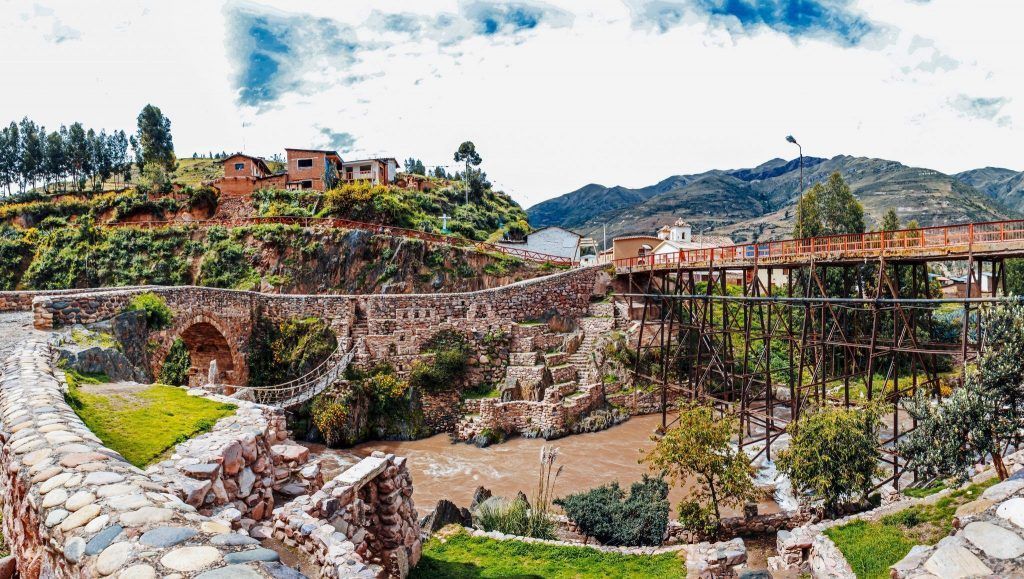
This bridge dates back to the 19th century, it is made of rail iron metal and it is the main connection route for vehicular traffic in Checacupe.
Recommendations for reaching the three bridges:
On your own:
- Take the buses that go to Sicuani on Avenida Manco Capac N ° 802, but you have to get off in CHECACUPE city (way before arriving at Sicuani), the buses normally leave every 1 hour. Please confirm the Bus terminal location to Sicuani with IPERU, you don’t have to go to their office that is in the Plaza de Armas of Cusco next to the church of La Compañía de Jesús, you can just call them, dial +51 84 237364 , they speak Spanish and English.
- The entrance to see the three bridges is 2 Soles per person.
Through a travel agency:
We recommend you taking the tour to the alternative colored mountain of Palccoyo, on this excursion you will not only see the three bridges, the Palccoyo mountain but also the Red River.
The Inca Bridge of Machu Picchu
This bridge is an impressive example of Inca architecture, located on a very narrow Inca trail, next to a granite mountain in the archaeological park of Machu Picchu.
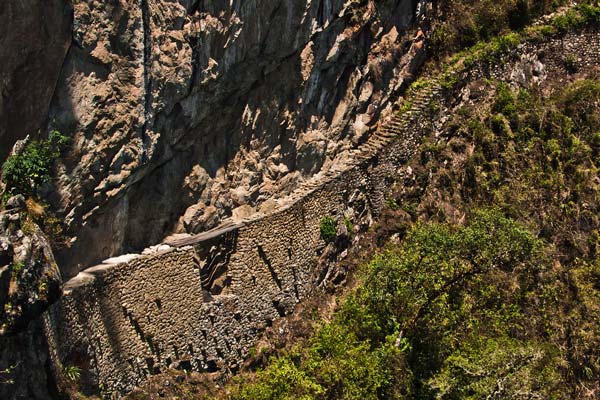
If you want to do a non-traditional tour to Machu Picchu and the park, you can visit this short bridge made of wood, please note that is experience is not suitable for people who suffer from acrophobia, the small wooden bridge is located just at 30 minutes walk from the Inca citadel of Machu Picchu.
The route
To access this Inca bridge, go to the Mirador (look out point) and from there you can see the hydroelectric, just go towards the hydroelectric power station.
The path is made up of earth and stone steps (no steep-walking), but please be careful, especially if you are going there with children, because the route is super narrow.
The walk from the main gate of Machu Picchu to the beginning of the trail is perhaps the most demanding section of the entire walk, the small walk will take you around 30 minutes one way.
Recommendations to hike to this place:
- Use trekking shoes as they are the most recommended for this type of trail.
- Always wear hats, sunglasses and a rain poncho.
- Use sunscreen and repellent.
- Bring an Official Identity Document, such as a Passport, you will need to present it to enter the trail.
- You only need to buy the Standard Entrance Ticket to Machu Picchu – You don´t need to pay extra money for this trail, as it is for Huayna Picchu.
- Note: You don´t need a Tour Guide to visit this place, but you do need a Professional Guide for your guided tour in Machu Picchu citadel!
The Carlos III Colonial Bridge of Paucartambo
This beautiful Carlos III Colonial Bridge is located on the Mapacho River in the colonial city of Paucartambo, unlike the Colonial Bridge of Checacupe which is made with a Roman Arch design, this bridge has an Ogival Arch design, ordered to be built King of Spain Carlos III in 1775, the construction lasted 5 years!
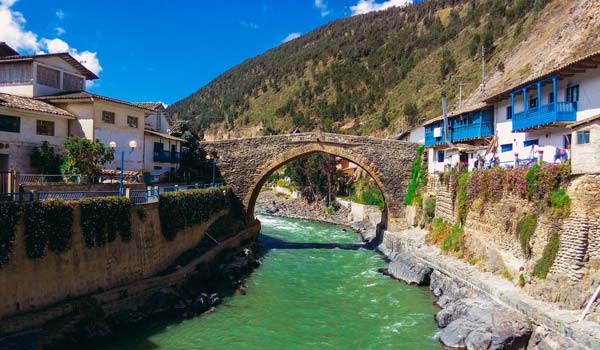
The Carlos III bridge is 34 meters long, 5 meters wide and 13 meters high (from the river), the floor is paved with small river stones.
Recommendations to get to this bridge:
On your own:
- If you are in Cusco city, go to the local bus terminal for Paucartambo at Avenida Diagonal Angamos 1952, the bus-ride price is 20 Soles and lasts 4 hours!
- Please confirm the Bus terminal to Sicuani with IPERU, you don’t have to go to their office that is in the Plaza de Armas of Cusco next to the church of La Compañía de Jesús, you can just call them, dial +51 84 237364 , they speak Spanish and English.
- Entrance is free!






